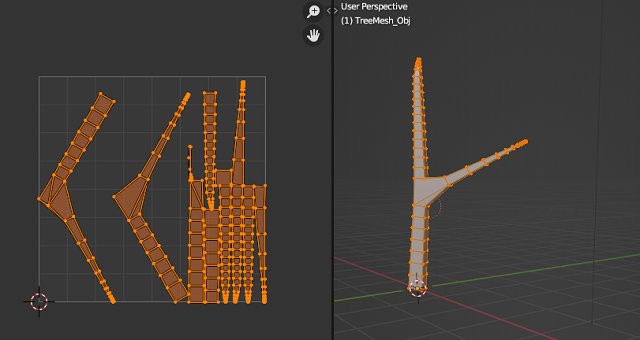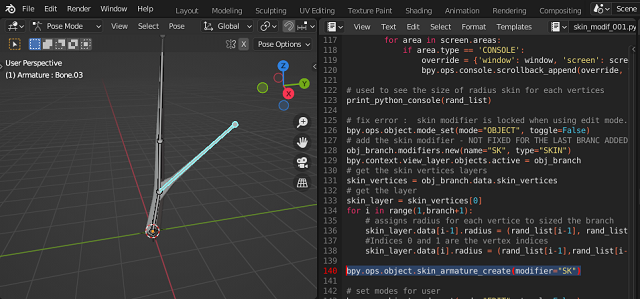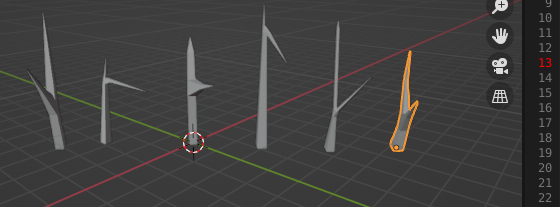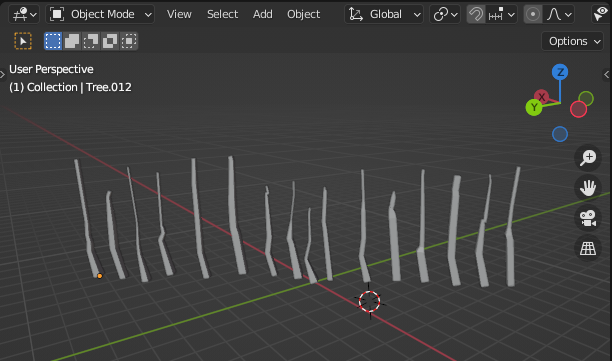Today I'm going to show you how to have a UV map for the entire mesh of the object created with the smart projection mode.
It's the same when you create a UV map using UV Mapping - Smart UV Project in the UV Editing view.
In principle, everything created in the Blender 3D interface has an equivalent in the A.P.I. of the 3D Blender.
You can see a screenshot with this script:

Here you see the source code that includes this option.
import bpy
import random
# import bmesh
import bmesh
MinNubmer = -10
MaxNumber = 10
# Clean up the area , uncoment the next two row to keep
# branch after running the script
#bpy.ops.object.select_all(action="SELECT")
#bpy.ops.object.delete()
# Number of branches
branch = 4
# Create the verts array
verts = [(0,0,0)]
# Create the edges array
edges = [(0,0)]
# Create the faces array
faces = []
# define random number for X and Y axis
def RN():
return random.randint(MinNubmer, MaxNumber) / 20
# define random number for positive Z axis
def RNZ():
return random.randint(10, 50) / 10
# create a list of branch thicknesses
rand_list = []
name_branch = "TreeMesh"
# define createBranch
def createBranch(branch, name_branch):
# Create the mesh for branch
mesh = bpy.data.meshes.new(name_branch)
for i in range(1,branch):
rand_list.append(RNZ()/30)
# sort all reverse by thicknesses
rand_list.sort(reverse=True)
# generate vertices list for drawing the branch
for i in range(1,branch):
verts.append((rand_list[i-1] +0.1,rand_list[i-1]+0.1,RNZ()))
edges.append((i-1,i))
# sort the list of vertices by last number witch is Z axis
verts.sort(key=lambda x: x[2])
# create branch update and validate, see documentation
mesh.from_pydata(verts, edges, faces)
mesh.update()
mesh.validate()
# Create object to hold the mesh branch with the new name for object
obj = bpy.data.objects.new(name_branch+'_Obj', mesh)
return obj
# create a new branch
def createNewBranch(obj_branch, n):
bpy.ops.object.mode_set(mode="EDIT", toggle=False)
me = obj_branch.data
bm = bmesh.from_edit_mesh(me)
bm.select_mode = {'VERT'}
for i,v in enumerate(bm.verts):
# select only by the index of list
if i == n:
v.select = ( v.co.x > 0.0 )
v2 = v
else:
v.select = False
# flush and update view
v1 = bm.verts.new( (RN()+(v.co.x) + 1.0 , RN()+(v.co.y) + 1.0 , (v.co.z) - (v.co.z)/3) )
#v1 = bm.verts.new(1, 1, 3)
bm.edges.new((v1, v2))
rand_list.append(0.01)
rand_list.sort(reverse=True)
# update
bm.select_flush_mode()
me.update()
#mesh.validate()
#bmesh.update_edit_mesh(obj_branch.data)
# use the createBranch
obj_branch = createBranch(branch, name_branch)
## now set up shape key in Blender
#mesh=obj_branch.data
#sk_basis = obj_branch.shape_key_add(name='Basis',from_mix=False)
#sk_basis.interpolation = 'KEY_LINEAR'
## must set relative to false here
#obj_branch.data.shape_keys.use_relative = False
## create new shape key
#sk = obj_branch.shape_key_add(name='Deform',from_mix=False)
#sk.interpolation = 'KEY_LINEAR'
#sk.slider_min = 0
#sk.slider_max = 2
# ... and add it to the scene
scene = bpy.context.scene
scene.collection.objects.link(obj_branch)
# this will fix the error ... mode_set_poll()
bpy.context.view_layer.objects.active = obj_branch
createNewBranch(obj_branch, 1)
# print tool for developing area
def print_python_console(data):
for window in bpy.context.window_manager.windows:
screen = window.screen
for area in screen.areas:
if area.type == 'CONSOLE':
override = {'window': window, 'screen': screen, 'area': area}
bpy.ops.console.scrollback_append(override, text=str(data), type="OUTPUT")
# used to see the size of radius skin for each vertices
print_python_console(rand_list)
# fix error : skin modifier is locked when using edit mode.
bpy.ops.object.mode_set(mode="OBJECT", toggle=False)
# add the skin modifier - NOT FIXED FOR THE LAST BRANC ADDED
obj_branch.modifiers.new(name="SK", type="SKIN")
bpy.context.view_layer.objects.active = obj_branch
# get the skin vertices layers
skin_vertices = obj_branch.data.skin_vertices
# get the layer
skin_layer = skin_vertices[0]
for i in range(1,branch+1):
# assigns radius for each vertice to sized the branch
skin_layer.data[i-1].radius = (rand_list[i-1], rand_list[i-1])
#Indices 0 and 1 are the vertex indices
skin_layer.data[i].radius = (rand_list[i-1],rand_list[i-1])
# this will apply the modifier named 'SK'
bpy.ops.object.modifier_apply( modifier = 'SK' )
#
bpy.ops.object.mode_set(mode="EDIT", toggle=True)
bpy.ops.object.skin_root_mark()
bpy.ops.object.mode_set(mode="OBJECT", toggle=True)
# set modes for user
mesh = bpy.data.meshes.new(name_branch+'_Obj')
mesh.update()
mesh.validate()
import math
def get_dimension(normal):
x_abs = math.fabs(normal[0])
y_abs = math.fabs(normal[1])
z_abs = math.fabs(normal[2])
if z_abs >= x_abs and z_abs >= y_abs:
return 2
elif x_abs >= y_abs:
return 0
else:
return 1
texture_scale = 1.0
bpy.ops.object.mode_set(mode="EDIT", toggle=True)
bpy.ops.mesh.select_all(action='SELECT')
me = obj_branch.data
bm = bmesh.from_edit_mesh(me)
bpy.ops.uv.sphere_project()
uv_layer = bm.loops.layers.uv.verify()
# adjust uv coordinates
for face in bm.faces:
for l in face.loops:
luv = l[uv_layer]
# select UV vertex if these are in certain range
if 0 <= luv.uv.x <= 1 and 0 <= luv.uv.y <= 1:
luv.select = True
luv = l[uv_layer]
luv.uv = l.vert.co.yz * texture_scale
luv.uv = l.vert.co.xz * texture_scale
luv.uv = l.vert.co.xy * texture_scale
bmesh.update_edit_mesh(me)
me.update()
bpy.ops.object.mode_set(mode='EDIT')
bpy.ops.mesh.select_all(action='SELECT')
bpy.ops.uv.smart_project(angle_limit=1.15192, island_margin=0, area_weight=0, correct_aspect=True, scale_to_bounds=False)
# use this for cylinder project for UV map
#bpy.ops.uv.cylinder_project(direction='ALIGN_TO_OBJECT',
#align='POLAR_ZX',
#radius=1.0,
#correct_aspect=True,
#clip_to_bounds=False,
#scale_to_bounds=True)
bmesh.update_edit_mesh(me)
bpy.ops.object.mode_set(mode="OBJECT", toggle=True)







